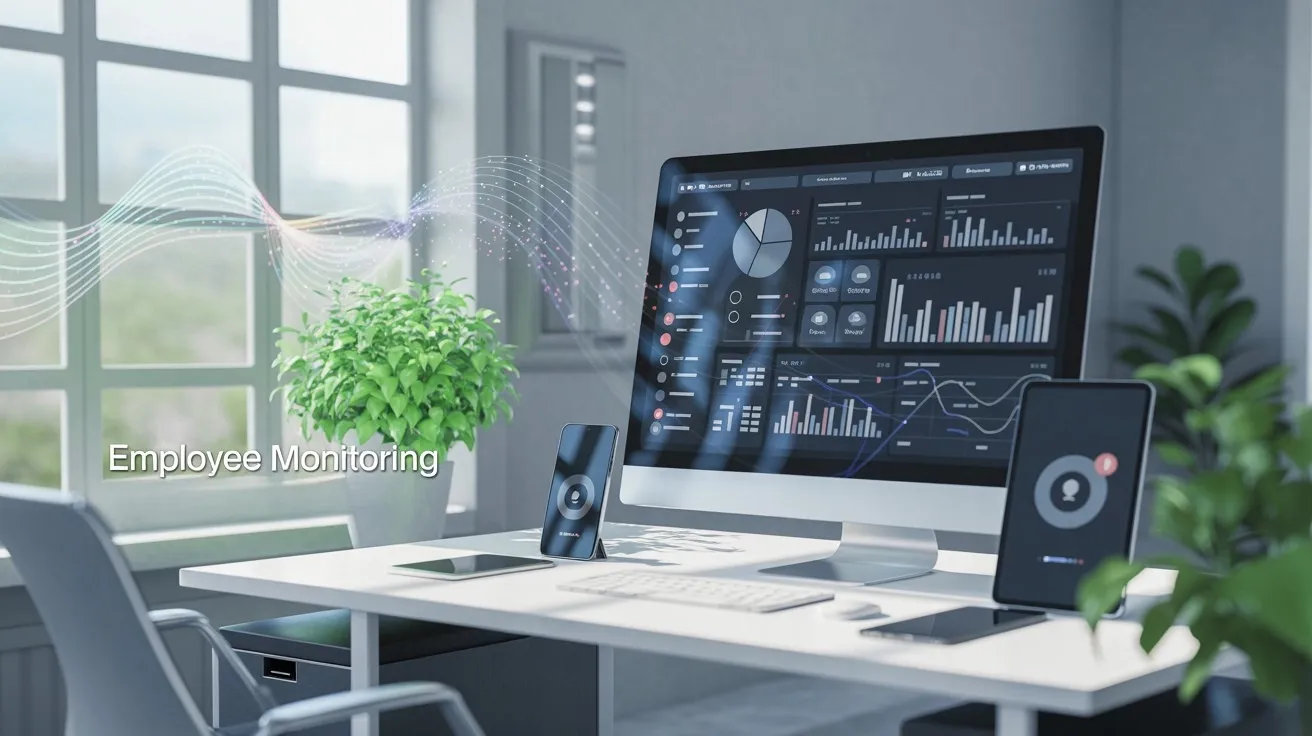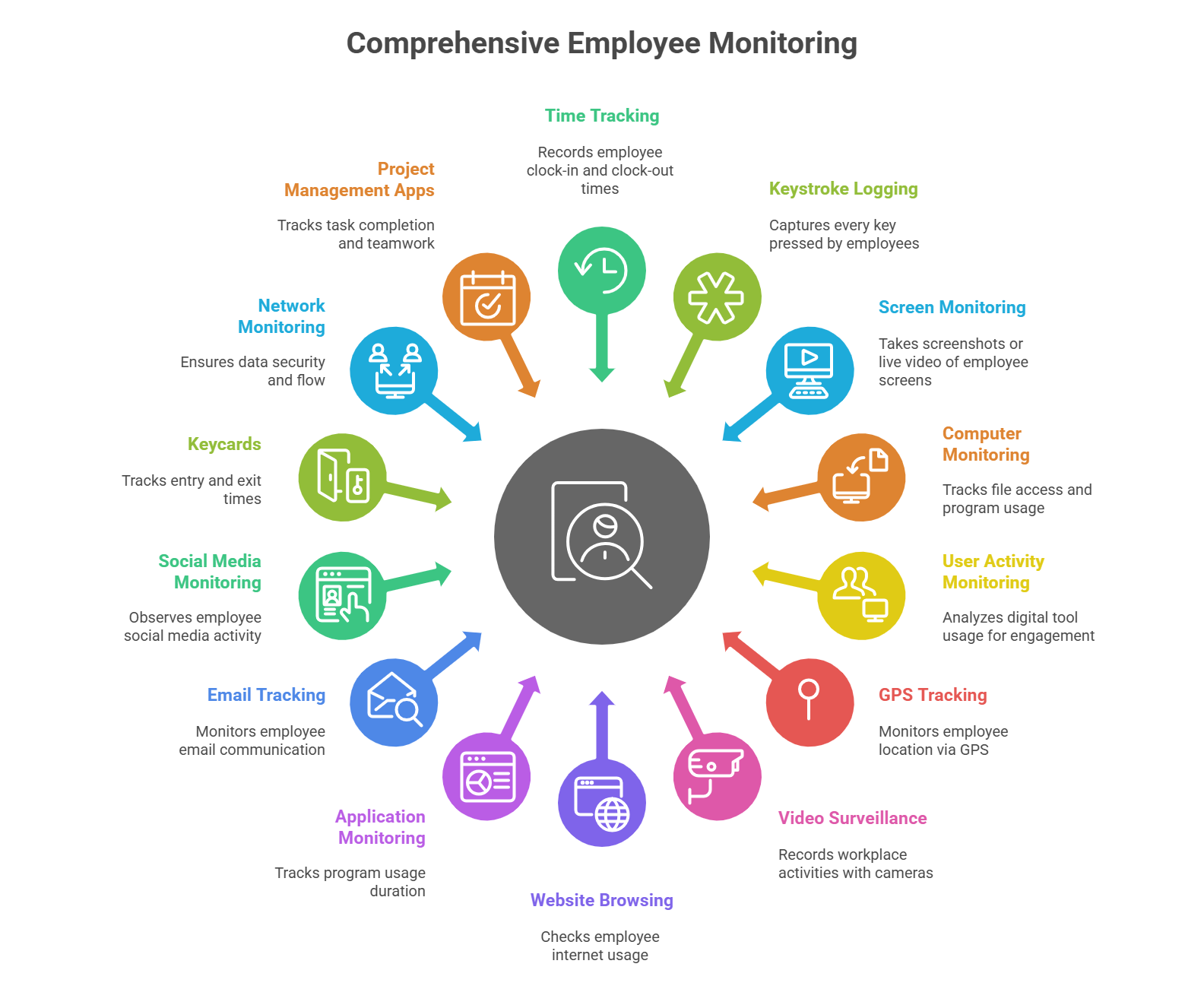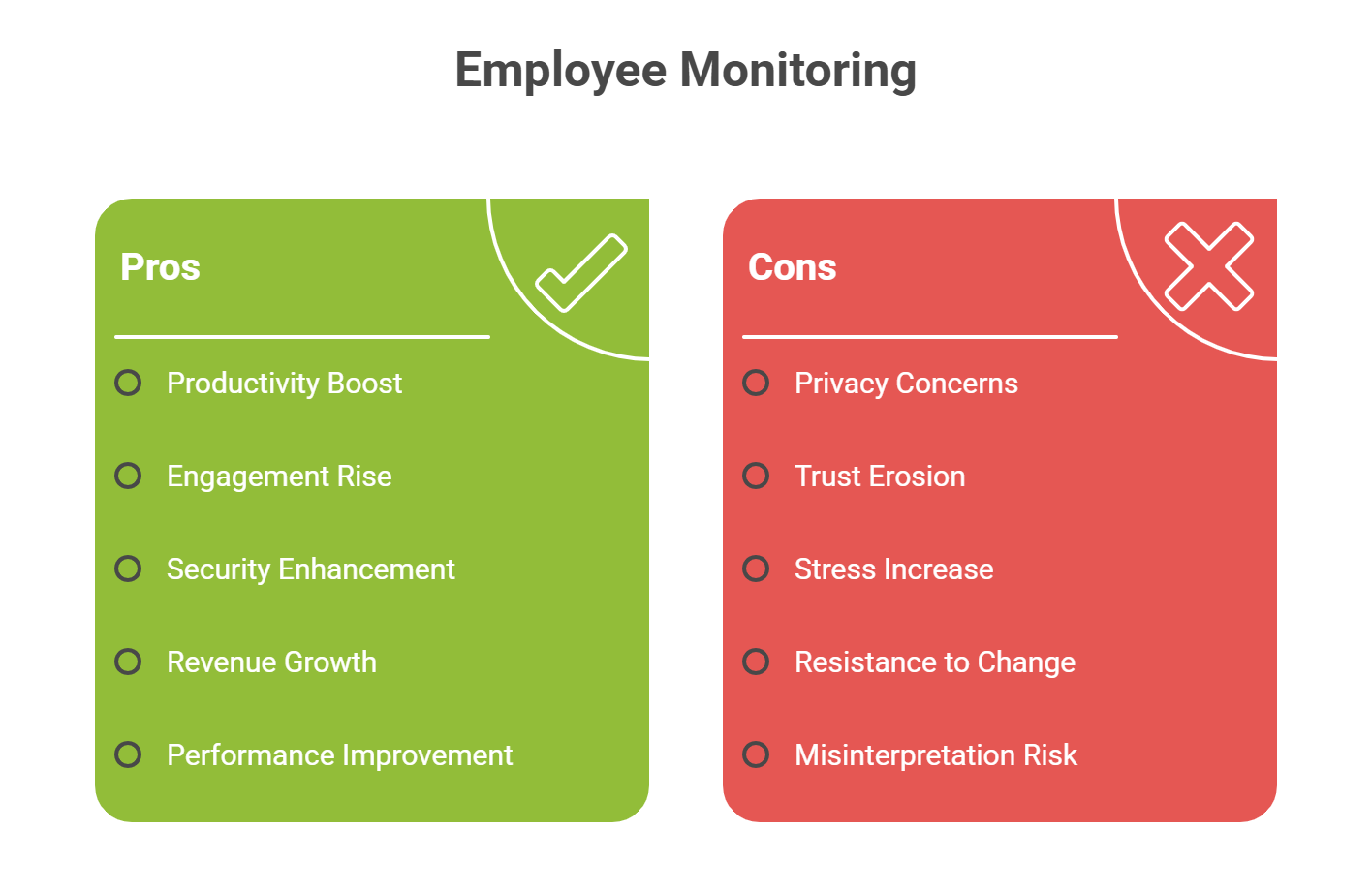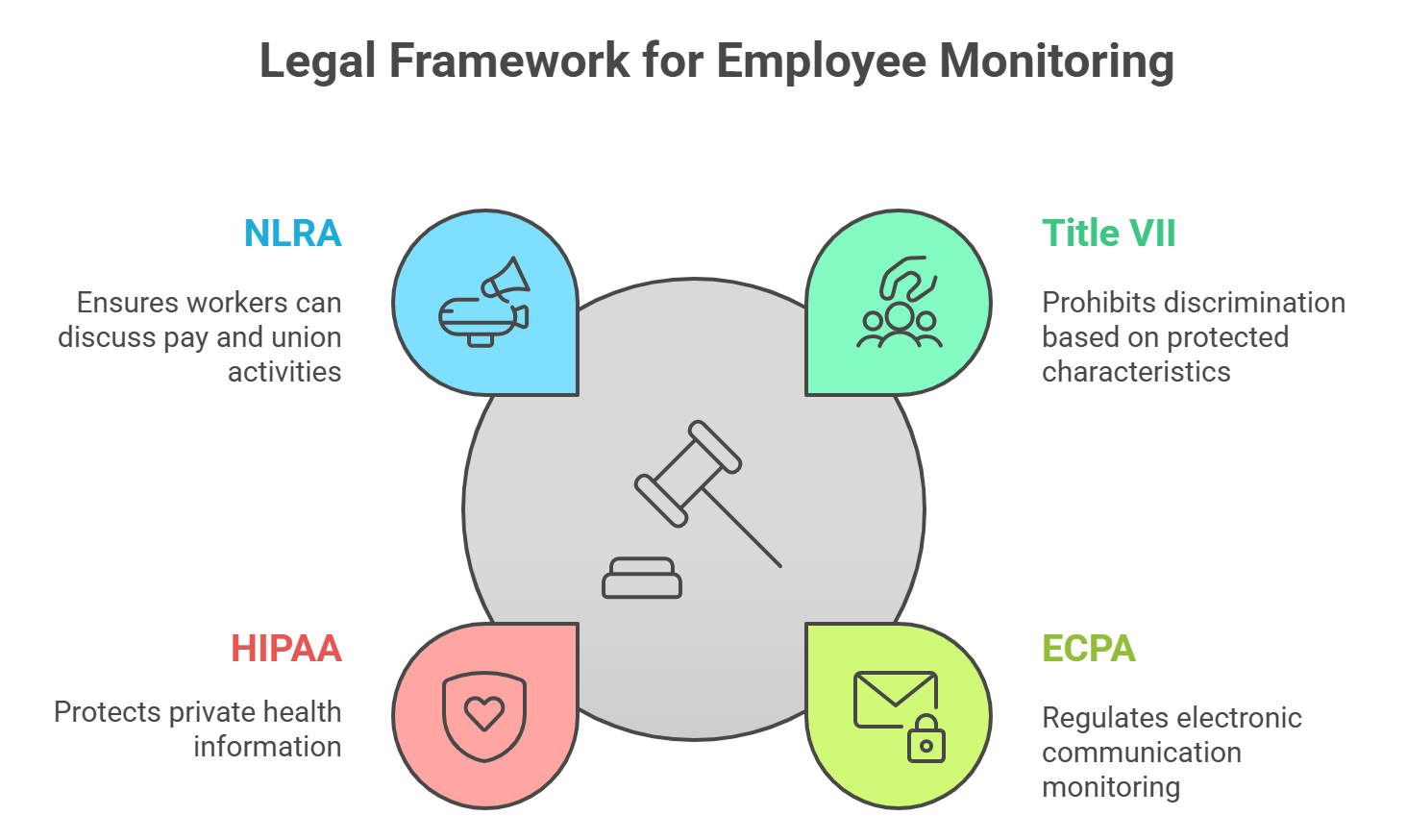What is Employee Monitoring? The Complete Guide

Summary:
-
Employee monitoring is supervising employee activities during work hours using monitoring solutions.
-
Most common employee monitoring types are: time and GPS tracking, computer activity, and network surveillance.
-
Productivity increases by 22% when you monitor your employees properly.
-
Laws and regulations could be a setback if you want to do extensive monitoring.
Over 70% of companies now use some form of employee monitoring software.
And as remote and hybrid work models become the standard, businesses are turning to digital tools to keep operations on track and safeguard sensitive information.
But what exactly is employee monitoring, and how does it affect both employers and employees?
Here, we’ll explore what employee monitoring is, the reasons behind its rise, the methods used, and how organizations can implement it responsibly.
In this article,
- Employee monitoring meaning
- Types of employee monitoring
- Technologies used for employee monitoring
- Pros & cons of employee monitoring
- Employee monitoring laws
- Implementing employee monitoring software
What is Employee Monitoring?
Employee monitoring refers to companies tracking their workers' activities during work hours. It's basically watching and measuring how employees spend their time, what they look at on their computers, and how well they do their jobs.
According to MIT research, 80% of companies are now monitoring their remote and hybrid workers. And Gartner found that 71% of all employees are being digitally monitored - that's a 30% jump from just last year.
Employee monitoring can be pretty basic, like just tracking employee attendance. But it can also be much more detailed. For example, companies might monitor everything you do on your computer, read your messages, or even track where you move around the office.
80% of traditional office companies track when employees come and go. And for remote workers, it gets more intense. About 37% of remote companies actually use video cameras to monitor their employees for 4 or more hours every single day. [Source: CBS News]
So, whether you work from home or in an office, there's a good chance your company is keeping tabs on what you're doing.
Start tracking team productivity for free!
Different Employee Monitoring Methods

These are the common & popular types of employee monitoring:
- Time Tracking: Keeping track of when employees clock in & clock out and take breaks. This helps companies see who's showing up and measures employee productivity.
- Keystroke Logging: Recording every single key that employees press on their keyboards. This shows how fast they type and what they're writing.
- Screen Monitoring: Taking screenshots or watching live video of what's on employees' computer screens while they work.
- Computer Monitoring: Watching everything employees do on their computers - like what files they open, what programs they use, and how well their computer is running.
- User Activity Monitoring: Studying how employees behave when using digital tools to see how engaged and productive they are.
- GPS Tracking: Using location services to track employees. It is especially helpful for workers who travel or use company vehicles.
- Video Surveillance: Using security cameras to record what happens in the workplace for safety and to watch employee behavior.
- Website Browsing: Checking employee internet usage and online activities during work hours to make sure they're using the internet appropriately.
- Application Monitoring: Keeping track of which computer programs employees use and how long they spend on each one.
- Email Tracking: Reading or monitoring employee emails to make sure they follow company rules and stay productive.
- Social Media Monitoring: Watching what employees post on social media, either on company devices or anything related to the company's reputation.
- Keycards: Using ID cards to track when employees enter and leave the building, and where they go within the workplace.
- Network Monitoring: Watching how data moves through the company's computer network and making sure everything is secure.
- Project Management Apps: Using employee monitoring software to track whether employees finish their tasks on time and how well teams work together.
Try different employee monitoring features for free!
What Type of Technology is Used for Employee Monitoring?
Here are the core tech types used for employee monitoring:
- Activity logging/usage analytics: Tracks apps and websites used, idle/active time, and focus time.
- Screen capture/screen recording: Periodic screenshots or short clips tied to timesheets or investigations.
- Time tracking/timesheets: Manual timers + auto-detect of tasks/apps; often integrates with payroll.
- Remote desktop/IT support tools: Let admins view or control devices for support (can be used to observe sessions).
- Network traffic monitoring (firewalls, proxies): Logs domains, bandwidth, risky destinations; may block exfiltration.
- Email/IM monitoring & archiving: Captures emails, Slack/Teams chats for compliance, retention, and DLP.
- DLP (Data Loss Prevention): Watches for sensitive data patterns moving via email, web, and USB.
- CASB & SaaS audit logs: Visibility into use of cloud apps (file sharing, downloads, external shares).
- SIEM/UEBA: Aggregates logs from many systems and flags anomalous user behavior (e.g., unusual downloads at 3 a.m.).
- Endpoint Detection & Response (EDR/XDR): Security-focused monitoring of processes, files, and threats on devices.
- Badge access (RFID/NFC) & smart locks: Logs entries/exits by door and time.
- Biometric time clocks: Fingerprint/face/iris for attendance; reduces “buddy punching.”
- CCTV/video surveillance: Cameras in facilities.
- IoT sensors & beacons: Motion, occupancy, or BLE beacons to understand space usage or safety compliance.
- MDM/UEM (mobile device management): Enforces policies on corporate phones/tablets (apps, encryption, remote wipe).
- GPS/telematics: Tracks location and driving behavior for delivery/service fleets; dashcams for safety.
- Geo-fenced time tracking: Clock-in/out allowed only at job sites.
- Quality monitoring & call recording: Records calls, screens, and metrics (AHT, silence, sentiment).
- Transaction surveillance (finance/healthcare): Flags policy or regulatory violations tied to specific workflows.
Get started with free monitoring solutions!
Advantages of Employee Monitoring
You can get the following advantages due to proper employee monitoring:
Productivity Enhancement
Employee monitoring spots problems like wasted time and slow processes. This lets managers improve how work gets done and helps employees perform better.
Douglas Academy, a Canadian robotics and coding school, is a great example. Their operations director, Mohammad D., used Apploye employee monitoring software to manage teachers working online and at different locations. In less than a year, they boosted productivity by 28%.
The employee monitoring software automatically took screenshots with time tracking during online classes to check teaching quality and measure productivity. This gave managers better oversight and helped them use resources more effectively while maintaining trust with teachers.
Boost your team's productivity by 28%!
Boost Engagement & Stop Disengagement
When you track what employees do, you get useful information. You can use this info to give better feedback, set clearer goals, and recognize good work. This helps workers see how they make a difference and keeps them motivated.
For instance, employee engagement went up from 66% in 2024 to 71% in 2025 after companies started using employee monitoring tools.
Improve Security and Data Protection
Did you know that 83% of companies dealt with insider attacks last year? [Source: IBM]
But the good news is you can easily protect your business by monitoring what employees do online. This helps you stop data breaches before they happen, catch unauthorized access to your systems, spot insider threats early, ensure operational compliance, and follow your security rules.
Think of it like having a security guard for your digital world. It keeps an eye on things so you can focus on running your business.
Protect your business from insider threats!
Increase Revenue
Tracking employee work helps people stay focused and finish tasks faster. It cuts down on waste, like spending too much time on low-value tasks or repeating mistakes. Managers can spot problems early, fix bottlenecks, and match the right person to the right job.
With clearer data, you can improve schedules, training, and tools. Work quality goes up, projects ship sooner, and customers are happier.
All of this reduces costs and brings in more sales, so revenue grows.
Cut costs and increase revenue today with Apploye!
Performance Management
Performance management works best when we use real, measurable data. It keeps evaluations fair and consistent. It helps us spot skill gaps and choose the right training. It also provides clear proof for promotions, raises, and new roles.
Overall, objective data lets managers make confident, unbiased decisions and support people’s growth.
Resource Optimization
Employee monitoring shows how people really use their time, software, and equipment.
When you see what’s used a lot and what’s sitting idle, you can move resources where they’re needed most.
This helps teams work faster, avoids paying for tools no one uses, and reduces waste.
Over time, these small fixes add up to lower costs and smoother operations.
Quality Assurance
Tracking employee work keeps quality high. You can see what’s going well and what needs attention. It lets you catch mistakes early, before they grow. You can give quick feedback and offer support or training.
Employee monitoring keeps the way you work consistent across teams and projects. This means fewer do-overs, smoother handoffs, and happier clients.
Attendance & Payroll Accuracy
Many employers lose about 4.5 hours each week per employee because of time theft.
Automated time tracking helps stop this. It also reduces payroll mistakes and makes sure people are paid for the exact hours they work.
In fact, with employee monitoring, payroll processing errors can drop by about 58%.
Stop time theft - save 4.5 hours weekly!

Disadvantages of Employee Monitoring and How to Address Them
Not everything about employee monitoring is good. For example:
Privacy
Monitoring can feel like spying. People may feel their personal space is invaded, especially if tracking goes beyond work tasks.
Solution:
- Be clear about what you collect and where the lines are.
- Track only work stuff, only during work hours.
- Let employees see their own data.
- Use tools that protect privacy and anonymize info.
- Get informed consent and explain the “why” in plain language.
Try privacy-focused monitoring features!
Employee Disengagement
Monitoring can send the message “we don’t trust you,” which hurts relationships and demotivates employees from working.
Solution:
- Be open and honest about the purpose.
- Involve employees in setting the rules.
- Use data to help and coach, not to punish.
- Measure results and outcomes, not every mouse move.
- Encourage teamwork and shared goals.
Increased Stress
Constant watching makes people anxious and stressed, which harms mental health and performance.
Solution:
- Monitor only what’s necessary for the job.
- Turn tracking off outside work hours.
- Offer stress-management tools and support.
- Choose less invasive methods.
- Balance productivity metrics with employee well-being.
Legal Concerns
Monitoring can break privacy and employment laws, leading to fines and lawsuits.
Solution:
- Keep up with privacy laws in all locations you operate.
- Follow rules like GDPR, CCPA, ECPA, and others that apply.
- Give proper notice and get consent when needed.
- Keep only the data you need, store it securely, and delete it on schedule.
- Run regular compliance checks and audits.
Monitor employees while abiding by laws with Apploye
Federal Employee Monitoring Laws

Title VII of the Civil Rights Act of 1964
Employers can't use monitoring to discriminate against employees based on protected characteristics like race, religion, sex (including pregnancy, sexual orientation, and gender identity), or national origin. They can't target certain groups for extra surveillance, use monitoring to harass people, or create policies that unfairly impact protected groups. Doing this violates federal employment law (Title VII).
Electronic Communications Privacy Act (ECPA)
The basic rule is simple: you can't spy on people's electronic communications like emails, chats, or phone calls without permission.
However, there are some exceptions. Companies can watch what happens on their own desktops during normal business activities, and they can also monitor if employees agree to it through a clear policy that workers sign or acknowledge.
You need to be extra careful in certain situations. This includes listening in on calls as they happen, monitoring personal accounts or devices, and recording phone calls since some states require everyone on the call to agree first.
The penalties for breaking these rules are serious. You could face fines up to $250,000, spend up to 5 years in prison, and get hit with major lawsuits where you'd have to pay damages. [Source: Congress.Gov]
Health Insurance Portability and Accountability Act (HIPAA)
HIPAA protects your private health information. Most employers aren't covered by HIPAA, but their group health plans are. HR staff handling health plan data must follow privacy rules - only access what they need and keep it secure.
Companies can't use your health information for job decisions without permission. This includes wellness program data, health apps, or medical leave details.
For example, Gulf Coast Pain Consultants paid $1,190,000 in penalties when a former contractor illegally accessed medical records of 34,310 patients without authorization. [Source: HHS.gov]
National Labor Relations Act (NLRA)
Workers can legally talk about their pay, working conditions, and union activities with each other.
If employers monitor or watch workers in ways that discourage these conversations - like tracking union chats or watching organizing meetings - that's illegal. Even regular monitoring tools can be a problem if they scare workers away from discussing their rights.
The employee monitoring needs to be transparent and focused, not designed to stop worker organizing.
Is Employee Monitoring Software Right for You?
What are My Goals?
Common goals that lead organizations to consider employee monitoring include:
- Improving productivity and reducing time waste
- Ensuring compliance with data security policies
- Managing remote/hybrid work arrangements effectively
- Tracking project progress and resource allocation
- Reducing insider threats and data breaches
- Providing objective performance metrics
- Optimizing workflow and identifying bottlenecks
See 40% better time tracking results right now!
Will Employee Monitoring Help Me Reach These Goals?
Absolute! Here are some real examples of companies successfully implementing employee monitoring software to get to their targets:
- FundedNext manages a 100+ global trading team with employee monitoring software - improving time tracking by 40%.
- Hubxpert uses employee monitoring to manage a hybrid team across 2 countries with 150+ projects.
- Jezweb achieved 50% payroll efficiency gains while managing a global team with employee monitoring tools.
- Wing Assistant runs a $30m global virtual assistant business using employee monitoring. They improved time-tracking accuracy by 40% and reduced payroll error by 30%.
How to Pick the Best Employee Monitoring Software
Below, I have developed a checklist to find the best employee monitoring system:
Core Capabilities
- Time tracking & idle detection - Baseline productivity & attendance
- App/website usage analytics - Measure focus vs. distractions
- Optional screenshots/redaction controls - Visual evidence; protect sensitive data
- File/USB/cloud transfer monitoring - Data loss/leak protection
- Keyword/keystroke alerts (with controls) - Early insider-risk signals
- Offline tracking - Continue monitoring without the internet
Track time, apps, and productivity seamlessly for free!
Deployment & Compatibility
- OS support (Windows/macOS/Linux) - Covers all endpoints
- Mobile support (iOS/Android) - Covers hybrid/field teams
- Easy deployment (RMM/MDM/SSO) - Reduce IT overhead
- Virtual desktop & terminal server support - Citrix/VDI environments
Privacy Controls
- Work-time scheduling & personal-time exclusion - Respect boundaries; avoid over-collection
- BYOD safeguards (no personal apps or content) - Reduce legal/privacy exposure
- Role-based access & least privilege - Prevent internal snooping
- Data minimization & configurable retention - Keep only what you need
Monitor employees ethically with built-in privacy controls
Security
- Data encryption in transit & at rest - Protect captured data
- Storage location options (EU/US/your cloud) - Data residency needs
Analytics & Reporting
- Custom dashboards & KPIs - Executive visibility
- Scheduled & ad‑hoc reports - Regular insights; audit support
Turn employee monitoring data into actionable insights
Usability & Support
- Clear UX for admins & employees - Adoption & fewer errors
- Onboarding, training, and documentation - Faster time‑to‑value
- Support SLAs & regional coverage - Reliable help when needed
Pricing & Vendor
- Transparent pricing & total cost (licenses + storage + add‑ons) - Avoid surprises
- Contract flexibility & exit/export options - Avoid lock‑in
- Customer references & case studies in your industry - Proof it works for peers
See clear pricing plans with no hidden fees or costs
How Long Before I can Benefit from the Employee Monitoring Software?
Here is the complete process:
Installation: 1–3 Days (SaaS) or 1–2 Weeks (On-Site/Complex Setup)
Installation means getting the employee monitoring software running on your computers and connecting it to your systems. If you're using a cloud version with easy installers, you can usually get most computers set up within a few days. You'll start seeing data as soon as devices connect.
On-site servers or complicated networks take longer, usually several weeks. That's because you need to test things first, get security approvals, and roll it out in stages.
Start collecting employee productivity data within days
Customization: 2–7 days for Basics or 1–2 weeks for Detailed Setup
Customization is about making the employee monitoring tool work for your needs. You'll set up things like policies, alerts, dashboards, and privacy settings. If you start with ready-made templates and keep it simple, you can have a working setup in about a week and start getting value right away.
If you require detailed, custom settings for different roles, special privacy rules, or connections to multiple other systems, it'll take longer, approximately a week or more.
The key is to start simple and add more later, rather than trying to perfect everything upfront.
Customize monitoring to match your team's needs
Learning Curve: 1–2 Days for Admins; 3–7 Days for Managers; 1–2 Weeks Company-Wide
This is how long it takes people to learn and trust the tool. With a user-friendly interface and quick training, admins usually get comfortable within a couple of days.
Then, managers can start using reports and understanding trends within the first week.
If the system is confusing or training is unclear, people will resist using it, which can push adoption to 2–3 weeks. Having clear processes, like a weekly review routine, helps everyone get up to speed faster.
So, with a straightforward cloud setup and basic configuration, you can get useful insights within 3–10 days. A typical deployment with some customization usually delivers benefits in 1–2 weeks. Complex setups with lots of integrations and legal reviews might take 2–4 weeks.
What are the Limitations of the Employee Monitoring Software?
Here are the problems with employee monitoring software:
Growing Your Team is Tough
When your company grows fast and hires more people, the employee monitoring software often can't keep up. It might start running slowly, crash completely, or force you to spend a lot of money upgrading your computer systems.
This is especially tricky when you have remote workers or people working from different locations.
Try scalable workforce solutions now!
Too Much Data Creates Issues
These employee monitoring programs collect tons of information. They take screenshots, track what people type, see which apps they use, and sometimes even record videos.
All this data takes up massive amounts of storage space and slows everything down. The more employees you monitor, the worse this problem gets.
One Size Doesn't Fit All
Most employee monitoring software is pretty rigid. Instead of letting you set it up the way your company works, you have to change how you do things to match what the software can do.
This makes it hard for employees to actually use it properly, and it might not fit your industry or company culture.
Try the best customizable monitoring system!
Doesn't Play Well with Other Tools
The employee monitoring software usually doesn't connect smoothly with the other programs your business already uses - like your HR system, project management tools, or payroll software.
This means you end up with information scattered in different places, and someone has to manually piece it all together to get the full picture.
Get seamless integration with project tools for free!
How can Employers Implement Employee Monitoring Software?
Here are the steps bosses should follow to successfully implement employee monitoring systems:
1. Involve Your Team Early
Ken Cox, President of Hostirian, says
"Transparency and consent are the only way forward. Without them, we risk creating a culture of fear and mistrust, which could have far-reaching implications for employee morale and, ultimately, business success".
61% of employees are comfortable with monitoring when it's used to support fairness and transparency.
Build trust with transparent monitoring!
2. Craft an Official Policy
Create a clear, written policy that explains what you'll monitor, why you're monitoring, how you'll use the data, and what rights employees have. Make sure it follows the law and covers the scope, purpose, data retention, and employee privacy rights.
3. Be a Reasonable Admin
Don't go overboard with employee monitoring tools. Use them wisely, not just because you can. Focus on what really matters for your business - like making sure work gets done, keeping things secure, and following the rules you need to follow.
Avoid tracking every little thing your employees do. That's micromanaging, and it doesn't help anyone. Instead, set clear limits on what you'll monitor and how you'll use that information. Keep it reasonable and fair.
Start balanced monitoring approaches now!
4. Be Flexible with Different Teams
Not every job is the same, so your monitoring shouldn't be either. What works for your sales team might not work for your creative department. Be ready to adjust your approach based on what each team needs and how they work best.
5. Don't Monitor Everything
Around 56% of employees feel stressed and anxious when monitoring feels too intrusive.
Just because your employee monitoring software can track something doesn't mean you should. Focus on monitoring things that actually matter for your business, security, or legal requirements. Give employees privacy during their breaks and personal time unless you have a real business reason to monitor those activities.
6. Set Up the Software to Fit Your Needs
Don't just turn on every feature because it's available. Take time to configure the employee monitoring features so they match your company's specific needs, culture, and legal requirements. Use only the features that help you reach your actual goals.
7. Keep the Data Safe
Once you're collecting employee monitoring data, you need to protect it properly. This means using encryption, controlling who can access the data, storing it securely, and having clear procedures for handling it. You don't want this sensitive information to get into the wrong hands.
8. Listen to Your Employees
Create easy ways for your employees to share their thoughts about the monitoring system. Check in with them regularly to see how it's working and if there are any problems. This helps you improve the system and keeps your team's trust.
Try Apploye’s Employee Monitoring Software
Employee monitoring isn't just about watching what people do. When done right, it helps teams work better together and keeps everyone on the same page. The trick is being open about it and respecting people's privacy.
Finding good monitoring software can be tricky. You want something that works well but isn't complicated to use. That's where Apploye comes in. It's completely free, and over 1,400 companies already use it.
The employee monitoring software provides real-time productivity tracking, automated time logging, screenshot monitoring, and project management integration.
Apploye is upfront about what it does. It follows privacy rules and helps you monitor your team without breaking their trust. Plus, it works on computers, phones, and web browsers - perfect for teams that work from different places.
If you manage remote workers, need to track billable hours, or want to help your team be more productive, Apploye might be what you're looking for. You get professional features without paying anything upfront.
Start free remote team monitoring now!
FAQs
What is the meaning of employee monitoring?
Employee monitoring is when companies track what their workers are doing. This includes watching computer use, emails, location, and productivity. Companies do this to ensure work gets done, protect information, and enforce workplace rules.
Is employee monitoring legal?
Yes, your employer can keep tabs on you, but they can't spy on everything you do. There are limits, and these limits change depending on where you work. The key is that any monitoring needs to be reasonable and related to your job. If you're unsure about what's allowed at your workplace, check your employee handbook or local laws.
Can I tell if my employer is monitoring my computer?
Check Task Manager for unknown programs, review your installed software and browser extensions for anything unfamiliar, use Resource Monitor to spot data being sent to external servers, and watch for slow performance or unexpected webcam/microphone activation.
Do employers have to tell you if they install monitoring software?
Monitoring disclosure requirements varies by location. Most US states require notification, but rules differ. EU's GDPR mandates clear disclosure. Canadian provinces typically require notification, sometimes consent. Companies usually disclose through written policies explaining what's monitored and why.
What does employee monitoring software do?
Employee monitoring software tracks employee computer activity, including screen use, keystrokes, emails, files, work time, and location. Companies use it to measure productivity, ensure policy compliance, and protect data. The software runs visibly or hidden in the background and generates reports for managers.
What is the best employee monitoring and productivity tool?
Apploye is an all-in-one employee monitoring tool that takes screenshots, tracks activity, and monitors apps and websites across all devices. It also handles project management, invoicing, attendance, and reporting, saving businesses money by combining multiple functions in one platform.
Should employers monitor social media?
Companies monitoring employee social media creates tension between business protection and privacy. Instead of broad surveillance, create clear social media policies that focus only on public posts directly affecting the company. Transparent guidelines work better than monitoring for maintaining standards and trust.
How is employee monitoring linked with data confidentiality?
Employee monitoring collects sensitive worker data like emails and browsing habits, which must stay confidential. These same monitoring systems protect company data by detecting unauthorized access and policy violations. Companies must balance using monitoring to safeguard business information while keeping the collected employee data secure and compliant with privacy laws.
How does employee monitoring software work?
Employee monitoring software installs on company devices to track screens, websites, apps, and keystrokes. It sends this data to managers who can view real-time activity, generate reports, and receive alerts for policy violations. The software categorizes activities as productive or personal to help employers monitor productivity and ensure compliance.
What is employee monitoring software for business?
Employee monitoring software tracks worker activities like computer usage, websites visited, keystrokes, and screen activity. Companies use it to increase productivity, ensure policy compliance, protect data, and verify remote work. It ranges from basic time-tracking to comprehensive workplace surveillance systems.
How does employee monitoring software fail to address cybersecurity threats?
Employee monitoring software doesn't protect against cyber attacks - it just watches employees while hackers, malware, and ransomware attack your systems from the outside. It only shows what has already happened instead of preventing attacks, and gives you false security that might make you skip real cybersecurity tools. If you want actual protection, you need firewalls and antivirus software, not employee monitoring.
What are the consequences of excessive employee monitoring?
Too much employee monitoring diminishes trust, stresses people out, and actually hurts productivity. Workers start deceiving the system rather than focusing on real work. So, creativity dies, and good people quit. This damages your reputation as an employer and creates legal and privacy issues.
How long before I can benefit from the employee monitoring software?
You'll see immediate benefits like activity logs and alerts within hours or days of installing employee monitoring software. Real value kicks in after 2-4 weeks once you've rolled it out, communicated policies, and tuned settings. Organization-wide improvements like better processes and trend insights typically take 1-3 months to develop.
How can you communicate about employee monitoring to employees?
Tell employees about monitoring before you start. Explain what you're watching, why, when, and how. Provide a clear policy with a legal basis. State what data you collect, who sees it, and retention periods. Explain benefits and privacy protections. Give employees the right to access data and raise concerns.
How do remote employers monitor their employees' productivity?
Remote employers track productivity by measuring outputs, using project tools for progress monitoring, tracking time and computer activity, setting communication requirements, reviewing work quality, pulling system data, and aligning everything to company goals.

